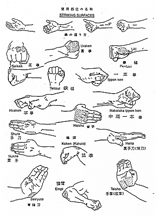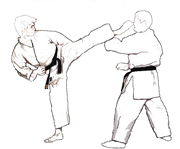
Chito Ryu Karate : Kumite (n. koo mee tay)
| Kumite is the combative side of Karate practice. As a martial art, Karate makes use of kicks, punches and strikes when engaging an opponent. Karateka learn early in their practice that they must never start a fight, but to always seek ways of avoiding one. However, if fighting is unavoidable, then the hands, feet, elbows and other weapons of Karate will be used in deadly earnest. |

Karate practice begins by teaching physical fitness and basic Karate moves - stances, blocks, strikes, punches and kicks. After the Karateka has developed sufficient strength, flexibility and skills, they will be introduced to simple, controlled forms of Kumite.
For children, whose enthusiasm sometimes extends beyond their physical abilities, one, three or five step techniques are introduced first, sometimes at a safe distance from their opponents. In Ippon-kumite, the attacker executes a strike or kick, the defended blocks and executes a counter strike and the two step away. In five step Kumite, the attacker executes one technique five times in a row while the defender steps back each time. After the last attack, the defended blocks and executes a counter strike. In this way the instructor can carefully introduce young karateka to more advanced fighting techniques. Older karateka may move quickly through these preliminary techniques and gain experience in free sparring.
Randori is like a free-flowing back-and-forth game of tag. Opponents square off and take turns executing one technique (kick, punch, strike). The opponent is given the chance to block or dodge the attack and return a counter attack, which is in turn blocked and countered. This goes on for periods of a few minutes with one karateka counting 20 or 30 strikes.
Full Kumite or free sparring is always done under controlled conditions, often with protective gear such as mouth guards, groin protectors, gloves and other safety equipment. Opponents square off and begin on command. There are many rules and restrictions on the target and types of attack but karateka must always keep in mind that such contests are done as friendly tests of each other's skills and not fights of anger or revenge. In competition, a referee and two judges control the fight to ensure that it is fair and the right karateka wins.
